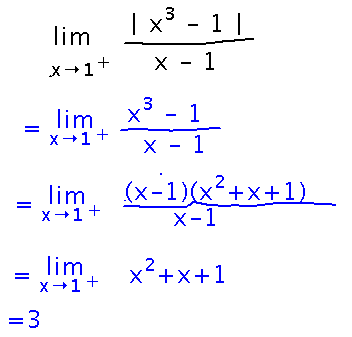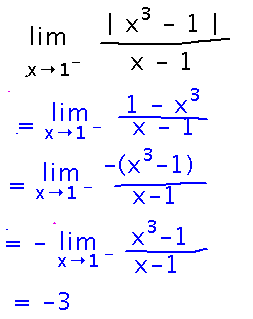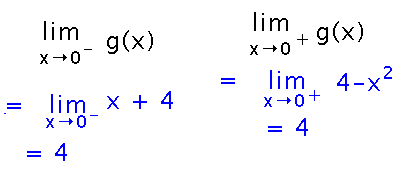Misc
SI session today, 3:00 - 4:30, Bailey 209.
Questions?
One-Sided Limits
Introduced in “One-Sided Limits” in section 2.2 of the textbook.
Example 1
Find limx→1- |x3-1| / (x-1) and limx→1+ |x3-1| / (x-1).

The absolute value in this function has a big impact on its behavior. Plotting it (and related functions) can help see how: here is a Mathematica notebook with the plot(s).
For both limits, the main trick is to rewrite the absolute value expression into something you can more easily do algebra with. But the absolute value rewrites differently depending on whether x3 - 1 > 0, in which case absolute value doesn’t change anything and |x3-1| = x3-1, or x3 - 1 < 0, in which case absolute value negates the negative number to get a positive one, i.e., |x3-1| = -(x3-1). Notice that these possibilities correspond exactly to the two one-sided limits.
It’s slightly easier to start with the limit from above, since the absolute value has slightly less impact there:

Now find the limit from below, reusing much of the work from finding the limit from above:

Does limx→1 |x3-1| / (x-1) exist?
No, because there’s no single value the function converges towards as x approaches 1. What number you converge towards depends on which side you approach 1 from.
This is an important role for one-sided limits, they provide a rigorous way to show that two-sided limits don’t exist.
Example 2
Define g(x) to be 4 - x2 if x ≥ 0, or x + 4 if x < 0.

Find limx→0- g(x) and limx→0+ g(x).
Once again, handle the two limits differently, this time according to which part of the function definition applies: one part applies when approaching 0 from below, because then x < 0, while another applies when approaching 0 from above, since then x > 0.
Both limits are easy to find just using limit laws, there’s no simplification needed:

Does limx→0 g(x) exist?
This time it does, since the one-sided limits are the same. This is an example of how you can used one-sided limits to find two-sided ones.
Key Points
Evaluating a one-sided limit from below typically involves taking the limit of a different function than evaluating the one-sided limit from above.
One-side limits are particularly appropriate when dealing with functions defined piecewise. This includes absolute value.
You sometimes use one-sided limits to show that two-sided limits don’t exist; conversely you also sometimes use one-sided limits to find that two-sided limits do exist.
Problem Set
See handout for details.
Next
Infinite limits.
Read “Infinite Limits” in section 2.2 of the textbook.